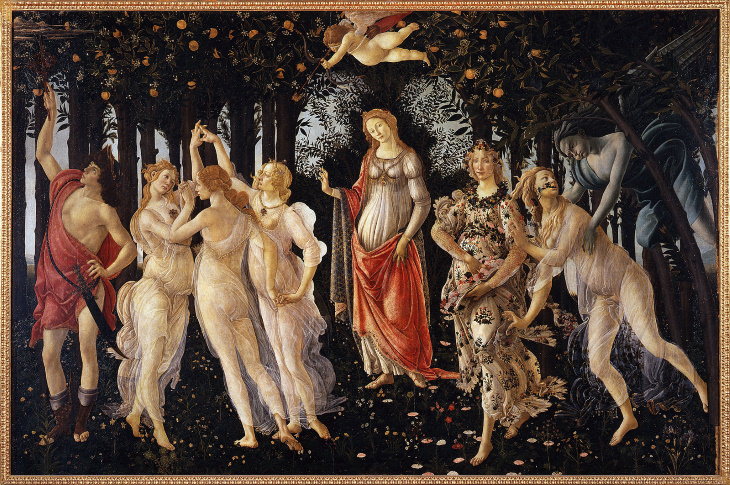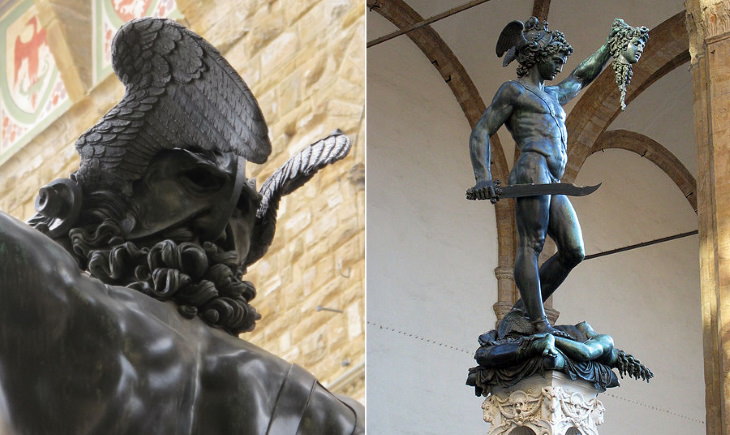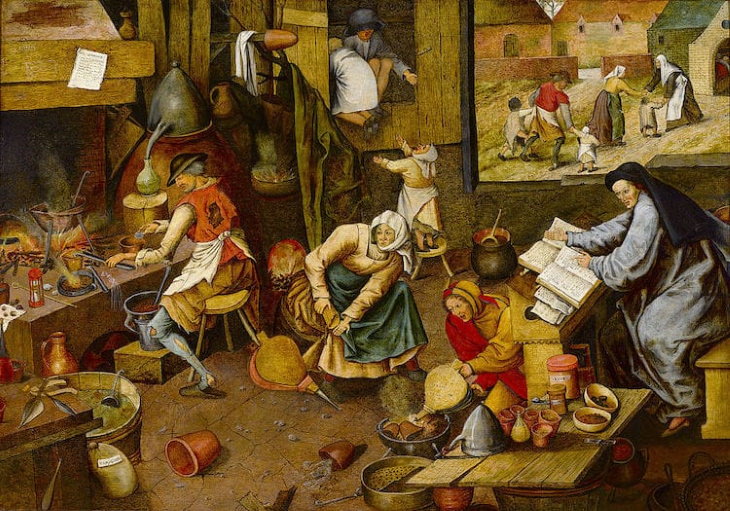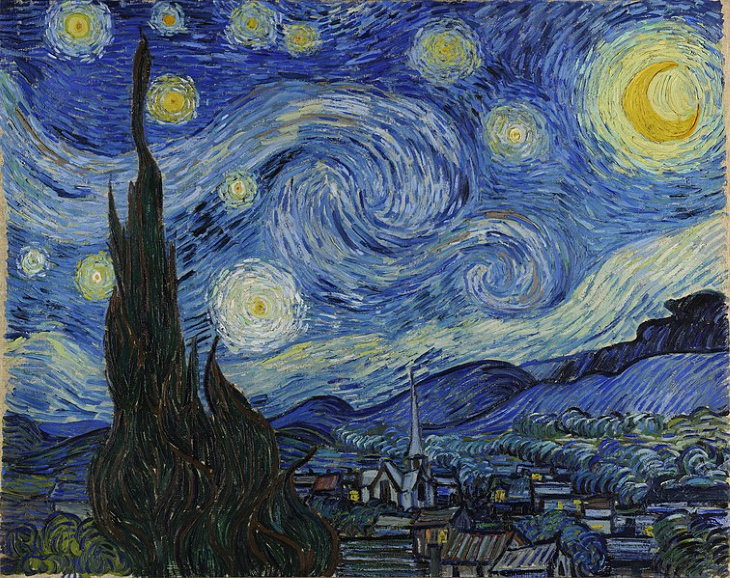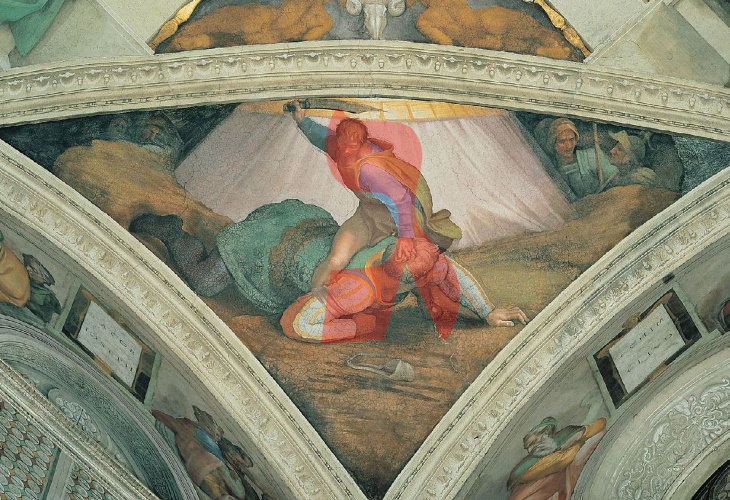1. 'The Separation of Light from Darkness' by Michelangelo (1509)
In a previous article titled 14 Hidden Messages In Famous Paintings & Sculpture, we showcased how certain details of the Sistine Chapel wall painting called the 'The Creation of Adam' by Michelangelo have anatomical references, but it turns out that the famous fresco is by far not the only reference to brain anatomy in the chapel created by Michelangelo. Another fresco titled 'The Separation of Light from Darkness', too, contains several anatomical references, namely to the cerebellum, optic nerves, the spinal cord, and the brainstem.
But how could the famous sculptor have such an excellent knowledge of anatomy, weren't dissections prohibited by the church at the time? Well, it actually turns out that for a short period at the beginning of the 16th century, when Michelangelo was a young man, public dissections of condemned criminals were briefly allowed by the Catholic Church. The young artist participated in around 30 such autopsies and made several anatomically-accurate sketches, which were discovered in the early 1600s. So, it is very likely that his inclusion of these anatomical brain structures in the Sistine Chapel was a way to share his knowledge.
2. 'Primavera' by Sandro Botticelli (1482)
'Primavera' is one of the most famous paintings by the Early Renaissance artist Sandro Botticelli. The painting is displayed at the Uffizi Gallery in Florence, Italy, and it's an ode to spring everlasting. The main characters pictured in the forest scene, including Venus, seen in the middle, the Three Graces on the left that represent beauty, chastity, and pleasure, as well as Flora, the goddess of spring wearing a dress adorned by flowers, are there to highlight the beauty of spring and all the good things we associate with it, such as love, the awakening of nature, and even marriage.
Every detail of the springtime scene is imbued with symbolism and meaning. To illustrate the amount of work and research put into this artwork alone, let's focus on the plant life in the painting, one of its most fascinating features. Art experts point out that this painting is a horticulturalist's heaven, as the mystical forest contains 500 different existing plant species, of which around 200 are flowers, fascinating!
3. 'Perseus with the Head of Medusa' by Benvenuto Cellini (1545)
Another art piece inspired by Greek and Roman mythology is Cellini's bronze sculpture picturing the victorious Perseus holding Medusa's head. This sculpture, too, is located in Florence, at the Piazza Della Signoria, to be precise. At first glance, the bronze sculpture depicts only two faces - that of the snake-haired Gorgon Medusa and the hero who slew her, Perseus.
However, if you have a sharp eye, you can take a peek at the back of Perseus’s helmet and see another face, the face of no other than the sculptor Cellini himself! There is also a signature of the artist on Perseus' belt.
4. 'The Alchemist' by Pieter Brueghel the Younger (1558)
Let's skip from Italian Renaissance art to the Golden Age of Dutch painting for a moment. Pictured above is 'The Alchemist' by Pieter Brueghel the Younger, a painting emblematic of the artist's style capturing ordinary peasant life in the 16th century. At first glance, the painting is a mere depiction of a busy day, but it actually has a strong moral undercurrent.
The painting shows a group of people engaged in alchemy, working tirelessly to conjure gold out of dirt, while a woman, the alchemist's wife is desperately searching for money in her purse. A hint to the family's future can be seen in the right upper corner - they are shown begging for coins. This part of the picture reveals the true consequence of alchemy - poverty - and warns the viewer to avoid making the same mistake of searching for gold without earning it, stealing, or cheating as a way to earn money.
5. 'Morning in a Pine Forest' by Ivan Shishkin (1889)
Considered to be one of the most famous paintings in Russian art, the 'Morning in a Pine Forest' is a proud feature of the Tretyakov Gallery in Moscow and a beautiful example of Ivan Shishkin's forest landscapes. But for a long time, people had no idea that this painting was actually a joint project between the famous landscape artist and realist painter Konstantin Savitsky, who was the one who drew the mother bear with the three cubs.
Being a landscape artist and worried he wouldn't be capable to capture the bears as well as he had envisioned, Shishkin asked for Savitsky's help with the painting. When the painting was purchased by the prestigious gallery, Savitsky asked to withdraw his authorship, arguing that the concept and idea belonged completely to Shishkin. For decades, few people actually knew about the co-authorship.
6. 'The Starry Night' by Vincent Van Gogh (1889)
What else could possibly be said about this painting, you might ask yourself? We completely understand the sentiment, as 'The Starry Night' is definitely among the most recognized and talked about paintings in history. Alas, the Van Gogh masterpiece, too, may still have another trick or two up its sleeve, surprising everyone over and over. Only recently, art experts have realized that the curled clouds in the night sky actually depict a curious and complex phenomenon scientists have only discovered in 2004 called turbulent flow.
In a 2014 TED-Ed video, research associate Natalya St. Clair explained that "using the Hubble Space Telescope, scientists saw the eddies of a distant cloud of dust and gas around a star, and it reminded them of Van Gogh's 'Starry Night'". Having taken a closer look at Van Gogh's art, "they discovered that there is a distinct pattern of turbulent fluid structures… hidden in many of Van Gogh's paintings."
7. 'David and Goliath' by Michelangelo (1509)
Anatomical symbolism is by far not the only kind of Easter egg Michelangelo used while planning out the frescoes of the Sistine Chapel. In this depiction of David and Goliath, for example, he hides a very different allegory, a linguistic one. Art experts point out that David's stance was created intentionally to resemble the Hebrew letter "gimel", which we have highlighted in red for illustration purposes.
This letter has a symbolic meaning, as it is related to the word "gemul", which refers to justified repayment or conducting reward and punishment. This hidden symbolism fits in perfectly into the Biblical Story itself, providing yet another message from Michelangelo you never knew existed!
Share this article with those who love art, too!


